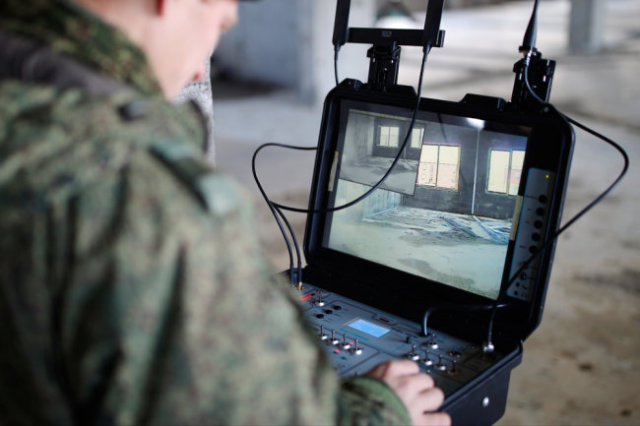The soldiers of the engineering units of the Russian army are almost always on the front line. People in special equipment and with mine detectors at the ready appear in the center of events in any military conflict. Military engineers are also involved in the elimination of natural disasters and emergencies.
To minimize the risk of accidental death, the sappers are supplied with the most modern means of protection. For example, the latest mine clearance suits OVR-2-02. They have already been tested in Syria and Nagorno-Karabakh. The suit protects the sapper from the explosion of anti-personnel mines of high-explosive and fragmentation action, as well as from bullets. It is equipped with an audio-video communication system, a portable water cooling system and hearing protection equipment. As the actual conduct of special operations, including in Syria, shows, the suits have repeatedly saved the lives of sappers.
Currently, mobile robotic mine clearance systems "Uran-6"are also actively used. The operator can control the complex from a remote control, being at a distance of up to 800 meters.
As the head of the Engineering Troops of the Armed Forces of the Russian Federation, Lieutenant General Yuri Stavitsky, told RG ,the latest multifunctional robotic complex for heavy-class mine clearance IMRTK-RT is being developed in the interests of the Russian Army. It is designed for making passages in anti-tank minefields and continuous demining of the area in remote control mode. This complex will be controlled remotely. In addition, work is currently underway to create an engineering multifunctional robotic complex IMRTK-SHR for the so - called engineering special forces-assault and barrage battalions. It will help engineering assault units to perform tasks under enemy fire in urban and industrial buildings. Also, new components of engineering equipment are being developed for sappers-attack aircraft - a passive exoskeleton and a backpack of a sapper-attack aircraft.
Military engineers should soon receive a new generation of remote mine clearance equipment. This system is designed to replace the UR-77 "Meteorite" installation, which has been in operation in the troops for more than 40 years, which was nicknamed the Serpent Gorynych in the troops. It has been successfully used for many years in most local conflicts from Afghanistan and Chechnya to Syria.
The updated "Snake Gorynych" is made on the basis of the BMP-3. It uses unique units in the form of an electric transmission with "batteries" - energy storage devices that allow the installation to silently drive up to three kilometers and imperceptibly reach the boundaries of application. High-efficiency mine-clearing charges are placed in a protected lifting launcher. The vehicle has elements of an active protection complex that neutralize enemy anti-tank ammunition. In addition, the equipment received a remote-controlled machine gun installation, which is capable of fighting ground and air targets.
To increase the mobility of troops, new means of overcoming destruction, obstacles and mechanization of earthworks are being created. The UBIM universal armored engineering vehicle, which was created on the nodes and aggregates of the T-72B3 tank, is already undergoing state tests. It is equipped with a combat module with a machine gun to defeat the enemy's manpower and lightly armored vehicles. A bulldozer blade with a variable position of the wings and a powerful pincer-type excavator bucket are mounted on the tank chassis. Instead of a bucket, a hydraulic hammer can be installed to destroy concrete structures. UBIM is also equipped with traction and auxiliary winches for the evacuation of equipment. The machine kit includes a portable mine detector, a radiation and chemical reconnaissance device, hand tools and protective equipment. In addition to the crew of two people, there are places for three sappers.
According to Stavitsky, work is currently underway to create a tank bridge-laying machine MTU-2020. It has already been presented at the Army Forum. The carrying capacity has been increased to 60 tons, which allows us to quickly ensure the crossing of the latest T-14 Armata tanks, among others.
Also, a heavy mechanized bridge TMM-7 is being developed for engineering departments. It uses lightweight composite materials, which made it possible to increase the length of the bridge structure to 16 meters. The new bridge opening scheme, modern hydraulic equipment and increased automation of the bridge assembly process will reduce the time of bridge crossing equipment.
Stavitsky stressed that the achievements of science and technology are effectively implemented when creating fundamentally new and improving existing engineering weapons. At the same time, he noted that it is impossible to completely do with robots alone. "They can't make decisions on their own, so the human factor remains very important." Of course, the most careful attention is paid to the training of a sapper. To prepare a high-class specialist, years of hard training and training are necessary. For this purpose, in accordance with the instructions of the Russian Defense Minister, a concept for the development of the International Mine Action Center and the Central Research Testing Institute of Engineering Troops was presented.
A new laboratory complex for testing and a landfill base will be built on the territory of the mine control center and the testing institute.
At the same time, the principle of an open architecture will be used. This will help to simulate various conditions under which sappers will be able to study and test engineering weapons. At the same time, the real situation of its operation in various environments and climatic conditions will be reproduced. Practical skills of managing troops will also be practiced here.
For these purposes, it is planned to build an atrium with various climatic zones, a laboratory for modeling the command and control system. As well as a laboratory for monitoring physical, mechanical and functional characteristics, a transformable hydrodynamics research laboratory. Interactive training classes of engineering weapons, dynamic terrain models for conducting command and staff games will also be created.
Alexander Stepanov

